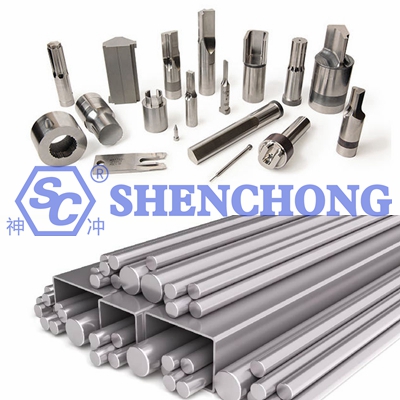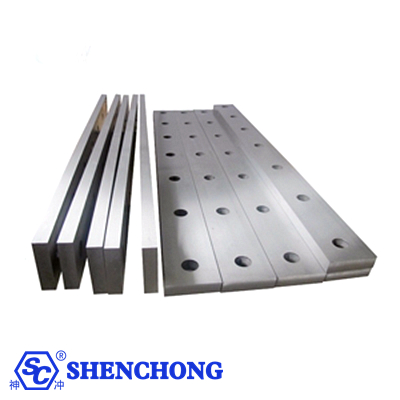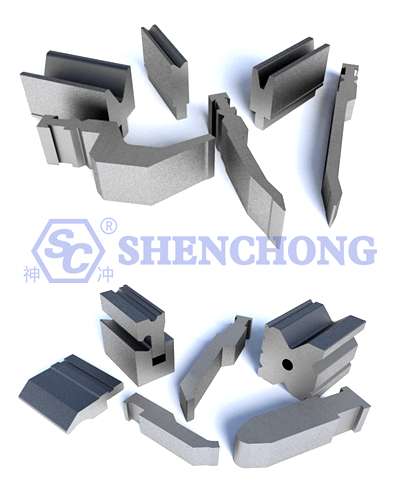
Steel for cold work tool is mainly used as a material for cutting and punching convex and concave molds for sheet metal. Mainly used for manufacturing molds for pressing workpieces in a cold state (room temperature). Such as cold stamping molds, cold stretching molds, cold extrusion molds, etc.
When the thin plate is punched between the convex and concave molds, it undergoes deformation in the initial stage. As the amount of deformation increases, the lower surface of the thin plate cracks due to large tensile stress.
During the usage process, as the wear of the concave and convex molds increases, the sharp corners of their edges gradually turn into rounded corners, resulting in a decrease in tensile stress on the lower side of the thin plate. The thickness direction of the thin plate is compressed, increasing the work hardening and deformation of the punched plate, and delaying the time for the plate to crack.
After cutting the blank, burrs are generated around the fracture surface. As the wear of the mold increases, the height of the burrs on the workpiece increases. When the height of the burrs exceeds the specified requirements, the mold needs to be replaced or repaired. Steel for cutting and punching molds is generally selected based on factors such as the type and thickness of the material being processed, the batch size of the produced workpiece, and the dimensional accuracy and shape complexity of the mold.

During the operation of cold working mold steel, due to the relatively high deformation resistance of the processed material, the working part of the mold bears great pressure, bending force, impact force, and friction force. Therefore, the normal reason for scrapping cold work mold steel is generally wear and tear. There are also cases of premature failure due to fracture, collapse force, and deformation exceeding the tolerance.
(1) Wear (2) Collapse angle (3) Plastic deformation (4) Fracture (5) Adhesion
During the operation of cold working molds, there are many frictions between the surface and the billet. In this case, the mold must still maintain a low surface roughness value and high dimensional accuracy to prevent early failure.
Due to the fact that the hardness and micro structure of mold materials are important factors affecting the wear resistance of molds, in order to improve the wear resistance of cold working molds, it is usually required that the hardness of the mold be 30% -50% higher than the hardness of the workpiece. The material's micro structure is tempered martensite or lower bainite, with uniformly distributed and fine granular carbides. To achieve this goal, the mass fraction of carbon in steel is generally above 0.60%.
The strength of a mold refers to its ability to resist deformation and fracture during operation. The strength index is an important basis for cold work tool design and material selection, mainly including tensile yield point, compressive yield point, etc. The yield point is an indicator to measure the plastic deformation resistance of mold parts and is also a commonly used strength indicator.
In order to achieve high strength, the toughness of the mold material in the mold manufacturing process should be determined based on the working conditions of the mold. For molds with strong impact loads, such as cold working molds, cold forging molds, etc., high toughness is required due to the large impact load. For cold working molds under general working conditions, they are usually subjected to small energy multiple impact loads, and the failure mode of the mold is fatigue fracture. Therefore, the mold does not need to have a high impact toughness value.
The ability to soften under heat reflects the influence of temperature rise on the hardness, deformation resistance, and wear resistance of cold work tool steel during load-bearing. The indicators that characterize the softening resistance of cold work mold steel under heating mainly include softening temperature (℃) and secondary hardening hardness (HRC).
The anti-seizure properties is actually the ability to resist cold welding. Usually, under dry friction conditions, the tested mold steel specimen is subjected to constant speed dual friction motion with materials with a tendency to bite (such as austenitic steel), gradually increasing the load at a certain speed, and the torque also increases accordingly. When the load increases to a certain critical value, the torque suddenly increases sharply, which means that bite occurs, and this load is called the "bite critical load". The higher the critical load, the stronger the anti-seizure properties.
The process performance of cold working mold steel is directly related to the manufacturing cycle and cost of the mold. The process performance requirements for cold working mold steel mainly include forging process, cutting process, heat treatment process, etc.
Forging not only reduces the machining allowance of mold materials and saves steel, but also improves the internal defects of mold materials, such as carbide segregation, reducing harmful impurities, and improving the micro structure of steel.
In order to achieve good forging quality, the requirements for malleability are low hot forging deformation resistance, good plasticity, wide forging temperature range, and low tendency for forging cracks, cold cracks, and precipitation of network carbides.

Low wear and smooth surface of the mold after processing. Cold work mold steel mainly belongs to hypereutectoid steel and ledeburite steel, and most cutting processes are difficult. In order to obtain good cutting performance, correct heat treatment is required. For molds with high surface quality requirements, free cutting mold steel containing elements such as S and Ca can be selected.
The heat treatment process mainly includes: harden ability, heat resistance, overheating sensitivity, oxidation decarburization tendency, quenching deformation and cracking tendency, etc.
SKS3, YK30, DF-2, etc. are commonly used to make short life molds, tool supports, etc. The harden ability is better than that of non-alloy mold steel, with high surface hardness and a certain degree of harden ability.
Represented by Cr5Mo1V (A2), including Cr4W2MoV, Cr5Mo1V, etc. Due to its relatively low carbon content and low chromium content, it belongs to hypereutectoid steel. The carbides in this type of steel are mainly Cr7C3 type, with a small amount of M6C and MC type, which have the characteristics of good wear resistance and small heat treatment deformation.
Represented by Cr12Mo1V1 (D2), including Cr12, Cr12W, Cr12MoV, Cr12MoV1, W6Mo5Cr4V2, 5Cr4W3Mo2VNb, 6W6Mo5Cr4V, etc.
① SLD, Cr12MoV, Cr12Mo1V1 (SKD11), XW-41, DC53, etc. are commonly used to make medium life mold steels. Has high compressive strength, high quenching hardness, good quenching toughness, and high wear resistance. Among them, Cr12MoV and Cr12Mo1V1 have higher harden ability, hardness, strength, and toughness after quenching and tempering compared to Cr12. Workpieces with a cross-section below 300-400mm can be completely quenched, and their wear resistance and plasticity are also good. They have small deformation but poor high-temperature plasticity, and are used in various casting, forging, and molds, such as various punching convex molds, cutting edge molds, rolling edge molds, seam molds, drawing dies, standard tools and molds. Cr12Mo1V1 has better harden ability and toughness than Cr12MoV, while the rest are the same.
② ASP23, ASP60SKH51, V4, V10, etc. are commonly used to make long-life mold steels. Has high compressive strength, high quenching hardness, good wear resistance and stability.
③ VIKING is a special type of multi-purpose tool steel with high toughness and wear resistance; Commonly used in situations where hot work molds have insufficient compressive strength and wear resistance, or cold work molds have insufficient toughness and are prone to breakage. Can be used for punching molds, stretching molds, engineering plastic molds, etc.

Carbon tool steel such as Q235, DF-2, O1, SKS3, YK30, etc .
Low alloy steel such as CrWMn, 9CrWMn, 7CrSiMnMoV, etc.
High speed steel, superhard high-speed or hard alloy steel such as Cr12, Cr12MoV, Cr5Mo1V, Cr5Mo1V, 7Cr7Mo2V2Si, etc.
When using carbon steel plates, silicon steel plates, and stainless steel plates with high stamping strength and high deformation resistance, higher grade tool steel with higher alloy content and better wear resistance should be selected based on the material's strength, thickness, and deformation resistance. For molds with larger cross-sectional dimensions, cold work tool steel with higher alloy element content and good harden ability should be selected.